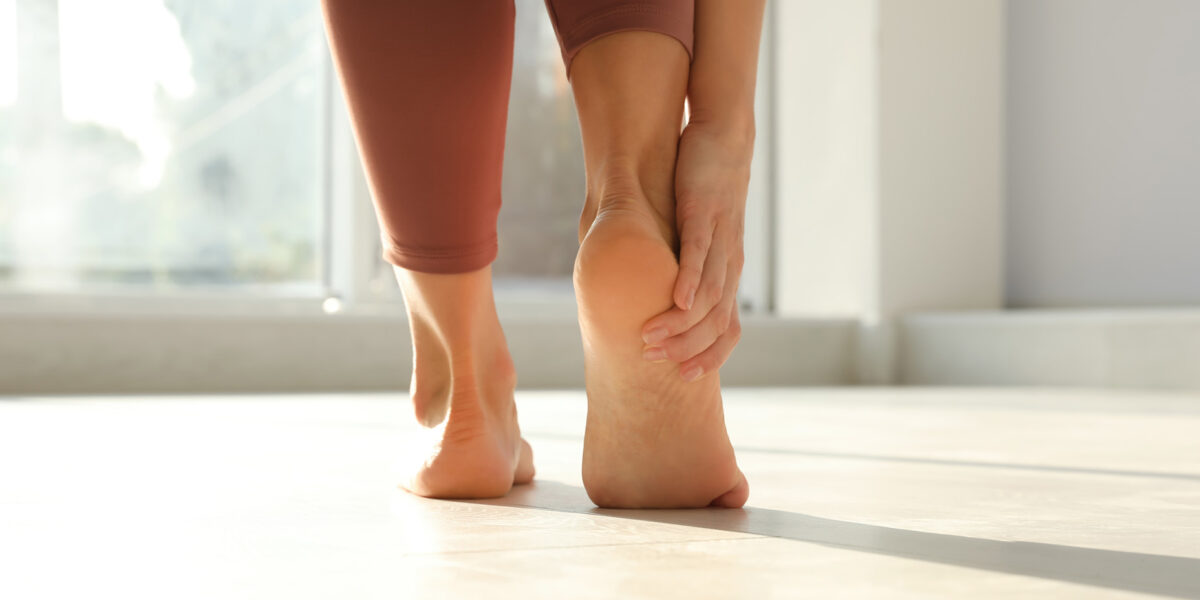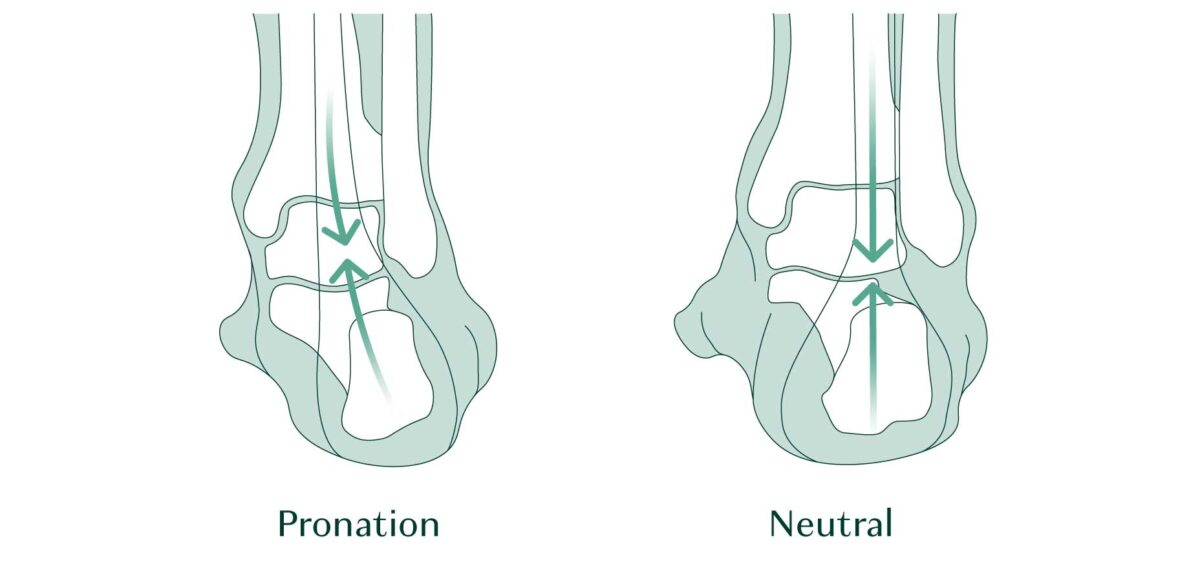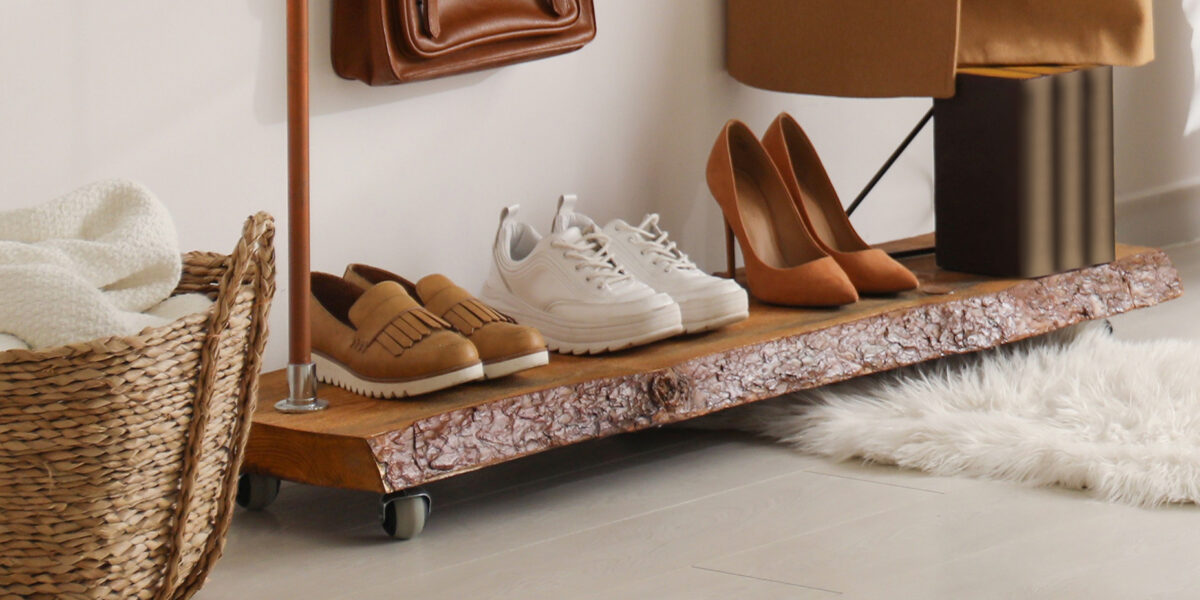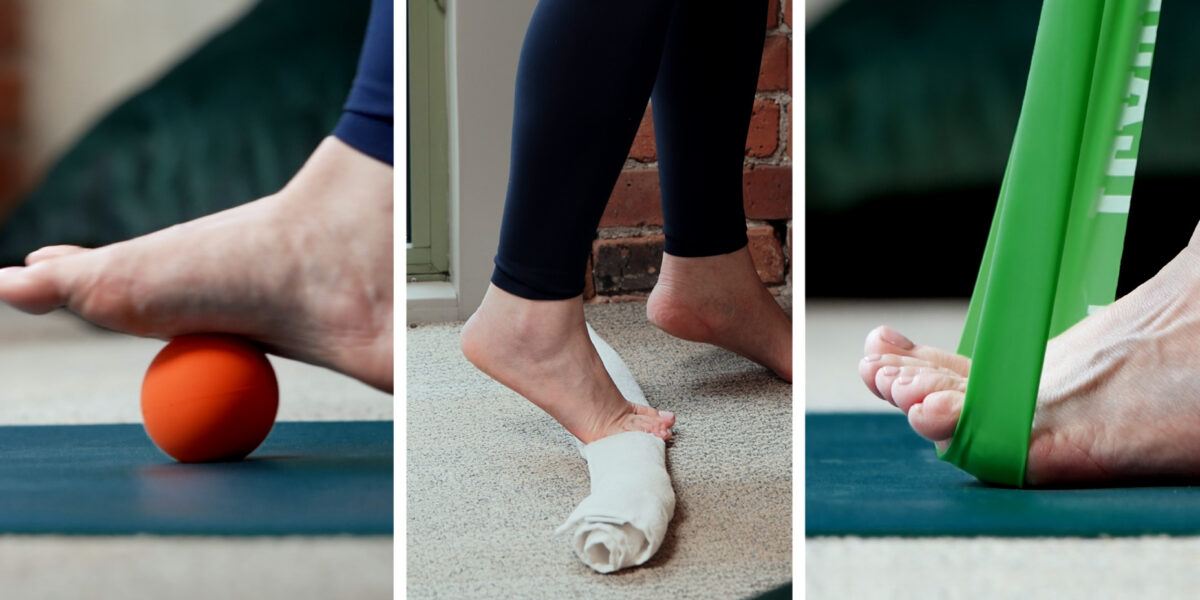Want to stay active as you get older? Of course you do. That’s why it’s so important to keep your feet in tip-top shape.
After all, you use them for everything. Like dancing? You need fit feet for that. Shopping? You need fit feet for that. Playing with the little ones? You need fit feet for that too.
As you know, nothing spoils your active, daily routine like pain that keeps you off your feet. If you feel a shot of pain in the bottom of your heel – particularly when you get up in the morning – you may be suffering from a common condition called plantar fasciitis.
And although it’s a common condition, it’s not one people talk about every day. So in this article, we’re taking a closer look at plantar fasciitis and its symptoms and causes.
Plus, we’re going to show you the BEST foot exercises to relieve pain and improve your strength, flexibility, and circulation (more on that later). That way, foot pain won’t prevent you from performing weight-bearing activities that keep your bones strong.
Oh, and the best part? These moves are quick, easy, and can be done from the comfort of your home.
Plantar Fasciitis Overview
What is Plantar Fasciitis?
Plantar fasciitis (fa-shee-EYE-tiss) is the most common cause of heel pain in the United States. More than 2 million people seek treatment for it each year.1
Many believe plantar fasciitis is an inflammatory process. But it’s actually characterized by a lack of inflammatory cells.2, 3, 4 In fact, research has revealed that the condition is actually a degeneration of the plantar fascia caused by repeated microtears of the fascia.5
How do these microtears come about? It turns out, they’re the result of repeated strain from standing too long or weight-bearing.
So let’s say you’re in the habit of walking, exercising, and doing all the cool things that let you live your best life. Although your plantar fascia is a beast and can handle high stresses from your daily activity, too much pressure harms or tears the tissues. And that spells trouble.
Eventually, you’ll notice a dull or sharp pain at the bottom of the heel or bottom mid-foot area.
And because life has a wicked sense of humor, you’ll be most aware of the pain when you take your first steps after resting. That’s right. After that good night’s sleep or mid-day nap, the first thing you’ll feel when your feet hit the ground is a jolt of pain. Yeah, it’s very annoying.
Although exercising or moving may temporarily relieve your pain, when you stop moving the pain usually feels worse.6
Approximately 50% of people who have this condition will also have heel spurs. But the spurs themselves are not the cause of plantar fasciitis.7

Plantar Fasciitis Risk Factors
Plantar fasciitis is most common among active men and women between the ages of 40 and 60.
In part, this is because the calcaneus (heel bone) fat pad begins to break down after 40. Plantar fasciitis is also reported to affect between 10 and 20% of injured athletes.8, 9
But other risk factors include:
- Running
- Obesity
- Heel pad atrophy
- Tight calf muscles
- Limited ankle dorsiflexion
- Anatomy (a high arch or flat feet)
- Prolonged standing on hard surfaces10
Foot Anatomy and The Plantar Fascia
Your foot is a complex structure composed of muscles, blood vessels, joints, and tendons. Each foot contains 26 bones — meaning that the feet account for about a quarter of all the bones in your body. 11
Your feet also contain ligaments — thick, strong fibrous connective tissues that connect bone to bone. The longest ligament of the foot is your plantar fascia.
This tissue runs from your heel bone to the base of your proximal phalanges (toe bones) to form the arch.
In addition to connecting the bones in your foot together, the plantar fascia acts as a shock absorber and supports the arch of your foot. It also assists with balance and helps you walk.12
Just think of your plantar fascia as a skilled coachman. His job is to guide the muscles in the sole of your foot and help coordinate all the structures during movement.
Physical Assessment: What’s Causing Your Plantar Fasciitis?
To figure out what’s causing your plantar fasciitis it’s best to work with a physiotherapist. Your therapist should be able to perform a thorough assessment to pinpoint causes of your plantar fasciitis. This may include a health and activity history, and simple physical tests.
In the meantime, there are a few things you should consider.
Achilles Tendons
Having a tight Achilles tendon (the big tendon at the bottom of your calf muscles above your heel) can affect your ability to flex your ankle.
And that can make you more likely to damage your plantar fascia.13 That’s why it’s common to find that those who struggle with a tight Achilles tendon also suffer from plantar fasciitis.
So how can you decrease that awful tension?
It’s simple. All you have to do is roll your calves on a foam roller. Tension in the Achilles tendons also responds well to a simple heel drop exercise.
To get the most out of this heaven-sent move, you’ll need to keep doing it for at least three months. When you do heel drops, consider adding a rolled towel under your toes for an added benefit — as you’ll see demonstrated in our calf raises exercise below.
Foot Overpronation
Another cause of plantar fasciitis is overpronation of the foot (i.e., when your foot rolls inwards). Overpronation can reduce the blood supply in the plantar fascia.
If this is the case for you, it would be helpful to work on strengthening the arches of your feet.
A great way to do this is to perform the toe curls and windshield wipers exercises featured below. These moves are so simple you can easily knock them out while getting caught up on your favorite TV show.

Toe Misalignment
If your big toe presses in towards your other toes it can create tension on the inside line of the foot. This can result in the cutting off of your blood supply to your plantar fascia.
If this is the case, there’s a simple fix. Just try spreading your toes to fire up the muscle on the inside line of your foot. You can also try wearing toe spreaders for about 10 minutes each day.
That’s right — just 10 minutes. So in the time it takes you to do a guided meditation on YouTube you can give your feet some much needed relief!
Ill-Fitting Shoes
When you struggle with plantar fasciitis, it’s important to support your arches. In doing so, you’ll reduce the stress across the plantar fascia and its attachment points. To support your arches just add some removable soles to your shoes.
But bear in mind that too much arch support can lead to further weakening of the arch muscles. So avoid adding too much cushion to your shoes.
Also, you should avoid wearing shoes that are too tight — even the cute ones. If your shoes are squishing your toes together that’s never good.
You should be able to spread your toes inside your shoes. And make sure that the toe side of your shoe is flat.

How Does Plantar Fasciitis Affect Bone Health?
When your feet are healthy, you don’t think twice about moving around. But when they’re in pain, it seems like your world comes to a stop.
You don’t want to run errands. You don’t even want to walk. And you certainly don’t want to perform those weight-bearing activities that keep your bones strong.
So struggling with plantar fasciitis can keep you from making progress on your bone health journey. And it can stop you from enjoying your everyday activities.
As you know, your feet play a crucial role in helping you keep your active lifestyle going.
After all, you use your feet every single day. So your plantar fascia doesn’t get a break from bearing the weight of your entire body.
That means your feet are more likely to continue experiencing pain and even fractures.
Foot Exercises’ Role in Fall Prevention And Healing Plantar Fasciitis
Research shows that people experiencing foot pain and plantar pressures are more likely to suffer a fall than those who aren’t.14
Thankfully, most of those tumbles only leave behind a minor bruise or scrape. But one out of every five falls does result in a serious injury like a broken bone.15
So what can you do to avoid being on the wrong side of that statistic?
Well, a randomized clinical trial published in the British Journal of Medicine shows that proper foot care can prevent falls.
The study showed that proper footwear, fall prevention education, and foot exercises reduced the number of falls in 305 older people (average age, 74) by 36%.16 But for the foot exercises to be effective, it’s important that they include massaging and stretching.
That’s because tight muscles in your feet and calves aggravate plantar fasciitis.
By adding massage and stretch exercises into your daily routine, you’ll relieve the tension and pain that come with this condition. You’ll also increase the blood flow in your foot which will help support the healing of your plantar fascia.17, 18
8 Easy Exercises & Therapies for Plantar Fasciitis (with Video Tutorials)
Massage & Stretch
For lasting relief, add some of these pain-relieving massage and stretch exercises into your daily routine. Now, they may be simple. But don’t let these bad boys fool you. They’re as effective as they are easy.
To perform them all you’ll need is a tennis or lacrosse ball, a small towel, and a resistance band. (Note: you’ll also find detailed written instructions for each pose next.)

1. Massage the plantar fascia with thumbs
The first technique involves massaging the plantar fascia with your thumbs. You’ll want to do this one first thing in the morning before getting out of bed.
- Rub lotion or oil on the bottom of your foot to reduce any friction.
- Using your thumbs, apply firm pressure along the center of your foot from the heel to the toes.
- After you do a few strokes up and down the foot, use circular or fanning motions to massage the fascia for two or three minutes.
2. Hand assisted stretch
The next technique is a hand assisted stretch. It’s also a great exercise to do after you wake up in the morning.
- Sit up straight in your bed and hold your heel with your hand.
- Put your foot in dorsiflexion, where the toes are pointing up. Lock in the position.
- Then with your other hand, pull your big toe backward, or toward your ankle.
- Do this move about 20 times to help elongate the fascia so it moves better.
3. Wall stretch
You can continue hydrating your fascia by taking your moves to the nearest wall. In addition to stretching your fascia, this move will also stretch your calf muscle.
- With your heel touching the floor, lift your foot and rest your toes on the wall.
- Lean forward to feel the stretch.
- Do this exercise three times, holding for 30 seconds each time.
4. Foot rolling
The next move will focus on massaging your fascia by rolling your foot with a ball.
- Grab a tennis or lacrosse ball and place it under your foot.
- Apply firm pressure and roll the ball back and forth from your toes to your heel.
- Do this exercise for two minutes to give your fascia a good stretch.
5. Calf raises with rolled towel under toes
This technique uses calf raises to help strengthen your fascia and relieve any tension in the Achilles tendons.
- Roll up a towel as tight as you can and place it under the toes of one foot.
- Placing your hands on a wall for support, slowly lift your heel up. Your other foot can gently rest on the ground to help with balance.
- Continue lifting and lowering your heel for about 20 reps.
- For added difficulty, try lifting your supporting leg off the floor.
6. Toe presses
This toe press technique will help improve circulation and strengthen the muscles and tendons below the foot. It can be performed with or without an exercise band.
- Sit in a chair with your knees bent and place a resistance band under your toes.
- Holding one end of the resistance band in each hand, pull up slightly to apply resistance, lifting your toes, but not your whole foot.
- Then, pull your toes down, working against the resistance, and then release back up.
- Continue this exercise for about 30 seconds.
- If you’re experiencing pain, ease up on the resistance, or even perform the same movement without the resistance band.
7. Toe curls/grabs (with a towel)
These toe curls will help strengthen your fascia, restore blood flow, and improve your foot’s circulation. You may find it easier to perform this exercise on a smooth surface like a wood floor.
- Sit on a chair with your legs parallel to one another and your knees bent at a 90-degree ankle so that your heels are directly below your knees.
- Place a small towel on the floor under the front half of one foot.
- Keeping your heel down, use all five toes to curl the towel towards you, scooping in with the arch of your foot. Release your foot.
- Repeat 10 times on each foot.
8. Windshield wiper
This exercise will help support both the anterior and posterior tibialis as it strengthens your fascia.
- Lift your leg up so your heel isn’t touching the floor.
- Lift your foot up then swing it out and up.
- Squeeze the muscles and pause.
- Swing your foot in and up, then squeeze the muscles and pause.
- Repeat 10 times on each foot.
Takeaways
Don’t let pain from plantar fasciitis cramp your active lifestyle. Instead, keep your feet strong, flexible, and pain-free with these tips:
Wear shoes that fit: Avoid wearing shoes that feel too tight. Regardless of how lovely a pair of shoes looks, if your toes can’t spread inside them, your feet are in trouble.
Support your arches: A great way to reduce the stress across the plantar fascia is to support your arches by adding removable soles to your shoes. But don’t overdo it since too much arch support can further weaken your arch muscles. And who wants that?
Exercise your feet: They’re often overlooked when it comes to exercise. But adding massage and stretch exercises into your daily routine is necessary when you struggle with plantar fasciitis. So take the time to try the exercises I’ve outlined above. Doing so will help relieve pain and help your feet become stronger and more flexible.
I hope you find these exercises useful. As always, please discuss any new exercises with your healthcare provider before adding them to your regimen. And if you have any other foot exercises or tips you’d like to share, please let me know in the comments section below.
For more information on bone health and healthy-living tips, sign up for our newsletter for regular tips and updates.
FAQs
What triggers plantar fasciitis?
Plantar fasciitis can be triggered by a number of factors, including:
- Running
- Obesity
- Heel pad atrophy
- Tight calf muscles
- Limited ankle dorsiflexion
- Anatomy (a high arch or flat feet)
- Prolonged standing on hard surfaces
What are 2 symptoms of plantar fasciitis?
A couple symptoms of plantar fasciitis are pain along the underside of your heel and difficulty raising your toes off the floor.
How can I get rid of plantar fasciitis?
Effective ways to treat plantar fasciitis include:
- Resting your foot
- Choosing footwear with cushioned heels and a good arch support
- Rolling your foot over a frozen water bottle to relieve pain
- Practicing the massaging and stretching exercises provided in this article
Is it OK to walk with plantar fasciitis?
When you struggle with plantar fasciitis it’s important to walk in a way that doesn’t cause increased pain. So be sure to:
- Wear shoes that fit your feet properly
- Wear shoe inserts to provide arch support
- Ice and stretch your feet after walking
- Avoid standing or walking on hard surfaces for long periods
References
- Tong KB, Furia J. Economic burden of plantar fasciitis treatment in the United States. Am J Orthop (Belle Mead NJ). 2010;39(5):227–231.
- Benjamin K. Buchanan, Donald Kushner, “Plantar Fasciitis,” National Library of Medicine, Last Update: May 30, 2022, https://www.ncbi.nlm.nih.gov/books/NBK431073/#
- Ling Y, Wang S. Effects of platelet-rich plasma in the treatment of plantar fasciitis: A meta-analysis of randomized controlled trials. Medicine (Baltimore). 2018 Sep;97(37):e12110. https://pubmed.ncbi.nlm.nih.gov/30212938/
- Lee YK, Lee M. “Treatment of infected Achilles tendinitis and overlying soft tissue defect using an anterolateral thigh free flap in an elderly patient: A case report.” Medicine (Baltimore). 2018 Aug;97(35):e11995. https://pubmed.ncbi.nlm.nih.gov/30170404/
- Luffy, Lindsey MSPAS, PA-C; Grosel, John MD; Thomas, Randall DPM; So, Eric DPM, “Plantar fasciitis: A review of treatments,” JAAPA 31(1):p 20-24, January 2018. |
- Mohammad Ali Tahririan, Mehdi Motififard, Mohammad Naghi Tahmasebi, and Babak Siavashi, “Plantar fasciitis,” J Res Med Sci. 2012 Aug; 17(8): 799–804. https://www.ncbi.nlm.nih.gov/pmc/articles/PMC3687890/#ref5
- Benjamin K. Buchanan, Donald Kushner, “Plantar Fasciitis,” National Library of Medicine, https://www.ncbi.nlm.nih.gov/books/NBK431073/
- Riddle, D., Schappert, S. “Volume of ambulatory care visits and patterns of care for patients diagnosed with plantar fasciitis: a national study of medical doctors.” 2004, Foot Ankle Int. 25(5):303-10.
- Taunton, J., et. al. “A retrospective case-control analysis of 2002 running injuries” 2002, Br J Sports Med. 36:95–101.
- https://www.ncbi.nlm.nih.gov/books/NBK431073/
- Robert MacGregor; Doug W. Byerly, “Anatomy, Bony Pelvis and Lower Limb, Foot Bones,” Last Update: May 29, 2022, https://www.ncbi.nlm.nih.gov/books/NBK557447/
- L. Daniel Latt, MD, PhD, David Eric Jaffe, MD, and Mihra S. Taljanovic, MD, PhD, “Evaluation and Treatment of Chronic Plantar Fasciitis,” First published online February 13, 202 https://journals.sagepub.com/doi/full/10.1177/2473011419896763
- Carla Stecco, Marco Corradin, Veronica Macchi, Aldo Morra, Andrea Porzionato, Carlo Biz, and Raffaele De Caro, “Plantar fascia anatomy and its relationship with Achilles tendon and paratenon,” J Anat. 2013 Dec; 223(6): 665–676, Published online 2013 Sep 12. doi: 10.1111/joa.12111 https://www.ncbi.nlm.nih.gov/pmc/articles/PMC3842207/
- Karen J Mickle, Bridget J Munro, Stephen R Lord, Hylton B Menz, Julie R Steele, “Foot pain, plantar pressures, and falls in older people: a prospective study,” J Am Geriatr Soc., 2010 Oct;58(10):1936-40. doi: 10.1111/j.1532-5415.2010.03061.x. Epub 2010 Sep 9., https://pubmed.ncbi.nlm.nih.gov/20831725/
- Wesley Vernon, “Prevention of falls through podiatry care,” BMJ 2011; 342 doi: https://doi.org/10.1136/bmj.d3052 (Published 16 June 2011), Cite this as: BMJ 2011;342:d3052
- Ravindra Puttaswamaiaha, Prakash Chandranb, “Degenerative plantar fasciitis: A review of current concepts,” The Foot, Volume 17, Issue 1, March 2007, Pages 3-9, https://www.sciencedirect.com/science/article/abs/pii/S0958259206000861
- Mario Roxas, “Plantar fasciitis: diagnosis and therapeutic considerations,” Altern Med Rev., 2005 Jun;10(2):83-93, https://pubmed.ncbi.nlm.nih.gov/15989378/





Cathy Stevens
March 29, 2023 , 4:05 pmActually, I was wondering if these exercises would also help with neuropathy?